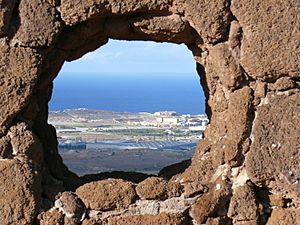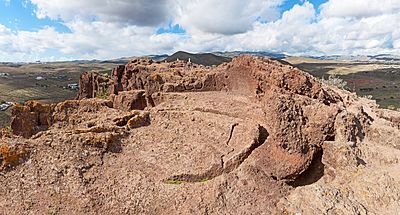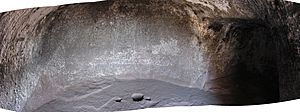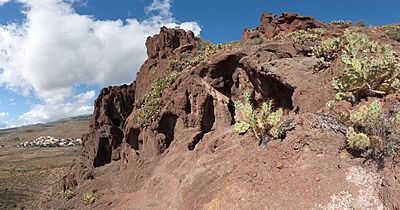Four Doors cave site, Telde facts for kids
Quick facts for kids Four Doors cave |
|
|---|---|
| native names: Cuatro Puertas, Montaña Bermeja | |
 |
|
| Location | Telde municipality, Grand Canary, province of Las Palmas, Canary Islands (Spain) |
| Elevation | 315 m (1033 ft) |
| Website | [1] |
| Four Doors cave | |
|---|---|
| Native name Spanish: Cuatro Puertas, Montaña Bermeja |
|

View from the Four Doors site
|
|
| Type | cave |
| Nearest city | Telde and Ingenio |
| Official name: Cuatro Puertas | |
| Type | Archaeological site |
| Designated | May 25, 1972 |
| Lua error in Module:Location_map at line 420: attempt to index field 'wikibase' (a nil value). | |
The Four Doors site, known in Spanish as Cuatro Puertas or Montaña Bermeja (meaning "Vermillion Mountain"), is a fascinating group of caves. It is located in the southern part of the Telde area on Grand Canary island.
The Cuatro Puertas site gets its name from its most famous cave, which has four large openings. This cave is very special to Grand Canary because of its unique look and location. The site also includes many other caves, some of which are connected. A small village nearby and a ravine (a narrow valley) are also named Cuatro Puertas.
This important site is recognized as a Property of cultural interest in Spain, meaning it's protected because of its historical value.
Contents
- Where is the Four Doors Site?
- What Can You See at Four Doors?
- Protecting the Site
- Other Nearby Archaeological Parks
- Similar Structures
- Images for kids
- See also
Where is the Four Doors Site?
The Cuatro Puertas and Montaña Bermeja sites are about 6 kilometers (about 3.7 miles) from the east coast of Grand Canary. They are on the east side of the GC-100 road, which connects Telde (5 km north) to Ingenio (8 km south).
The small village of Cuatro Puertas is easy to reach, located near the top of Montaña Bermeja. The main highway (GC-1) and Gran Canaria airport are only 6 km (3.7 miles) to the east. The cave site itself is east of the village, about a 500-meter (1,500-foot) walk on an easy path.
What Can You See at Four Doors?
Besides the famous Four Doors cave, this site has several groups of caves, a special ceremonial area, storage spaces for food, and old paths. All these features were carved into soft volcanic rock called tuff by the ancient people of Gran Canaria using stone tools.
Other caves at the site include the cueva de los Papeles ("Papers' cave"), cueva de los Pilares ("Pillars' cave"), cueva de la Audiencia ("Audience cave"), and the cantera de Molinos (quarry for grindstones). Most caves have a main central room with smaller rooms opening off it. It's believed that these caves were likely closed off with walls made of dry stones. The main rooms might have been divided using light materials like animal skins or stone lines.
The site covers almost the entire Montaña Bermeja, but only the upper part is open for visitors.
The Four Doors Cave (Cuatro Puertas)
The Four Doors cave, or Cuatro Puertas cave, is in the northern part of Montaña Bermeja, close to the top. It's a large, man-made cave, about 17 by 7 meters (56 by 23 feet), facing northeast. It was carved into tuff rock and has four big openings, all leading into one large space. These openings might have been covered with skins or other materials.
Outside the cave, there are about 20 holes in the ground. These holes show that the entire area in front of the cave was once enclosed, perhaps with a fence or structure.
People also made changes to the tuff walls and floors of the Four Doors cave. These changes were carefully planned to help observe the summer solstice, a special time of year when the sun is at its highest point.
What Was the Four Doors Cave Used For?
The exact use of the Four Doors cave isn't fully clear. However, because of its special location, large size, and closeness to a ritual site called an almogarén, many archaeologists believe it was a sacred place. It might have been used for worship and ceremonies led by important religious figures like the faycán (a spiritual leader) and harimaguadas (virgin priestesses).
The Ritual Place (almogarén)

At the top of the mountain, above and east of the Four Doors cave, there's another cave with a sacred area called an almogarén. This was a special place for rituals where people made offerings to their gods, such as Alcorac (the Sun). They would pour liquids like milk during these ceremonies. This almogarén is similar to one found at Roque Bentayga.
The Papers' Cave (Cueva de los Papeles)
The cueva de los Papeles ("Papers' cave") is on the south side of the mountain. You can reach it by following a path carved into the tuff rock on the mountain's south face, heading east from the ritual place.
This cave has a mostly circular shape. Its walls have various triangles carved into them, which are symbols linked to fertility. This suggests the cave was likely used for rituals related to this theme.
The Pillars' Cave (Cueva de los Pilares)
The same path that leads from the ritual place to the Papers' cave continues to the Pillars' cave (Cueva de los Pilares). You get to this cave through ramps, stairs, and small tunnels.
The Pillars' cave area was the main part of the ancient village on Montaña Bermeja, where people lived in caves. It faces south, which protects it from strong winds, and offers a wide view of the coast. It might have been surrounded by a thick wall made of dry stones. Most of the caves inside are roughly circular, with many having smaller side rooms. You can see depressions in the ground for cooking fires, holes in the walls for storage, seats, and grooves for wooden beams or door frames. These openings would have been covered with animal hides or woven plants.
This area also included granaries (places to store grain) and other hidden spots whose exact use isn't known.
From here, a path going east passes through a rock arch and a narrow "chimney" (a tight passage) towards the Audience cave. Further up the eastern slope, there's an interesting quarry where grindstones were made. However, this path is now difficult to use because it's overgrown with opuntia plants.
The Audience Cave
The Audience cave (cueva de la Audiencia) was used for many different things, such as sleeping areas, kitchens, and storage for food like grain. It's about 200 meters (650 feet) from the Four Doors cave, near a narrow and hard-to-find "chimney" passage.
The Mills' Quarry (cantera de Molinos)
How Were Hand Grindstones Made?
Stone grindstones were very important for daily life in the Canary Islands. Every day, people made gofio, a type of roasted flour, often from barley. Other flours were also used, especially on Gran Canaria, where farming was the main way people got food. This was different from other islands where raising animals was more common.
The grindstones were made from two types of stone: tuff (a soft volcanic rock) or basalt with many small holes (like a sponge). Both types of rock have a rough surface, which is good for grinding. However, tuff was used three times more often than basalt.
When grindstones were carved from the rock, they left round or oval hollows, like imprints, on the rock surface. These "negative imprints" are found all over the quarry, following the shape of the mountain. These traces are how archaeologists identify where grindstones were made.
On Gran Canaria, seven main places where grindstones were produced have been found. One of these is the Cuatro Puertas site in Telde.
Grindstone Production at Cuatro Puertas
There are two main areas where hand grindstones were made at Cuatro Puertas: one from ancient times and a more recent one right next to it on the east side. Both are on the lower part of the northern slope of Montaña Bermeja, along the path that leads from the village to the Four Doors cave. This area is between 197 and 210 meters (646 and 689 feet) above sea level. It's also near a military zone.
This quarry is in a good condition. Because it faces south, it has been protected from moisture and from being covered by lichens (small plant-like growths), unlike some other sites.
Protecting the Site
The Four Doors site has faced damage over time from natural forces like wind and water. But it has also been harmed by human actions. For a long time, many of the caves were used and changed to house goats and sheep.
In the 1950s, this archaeological area was even used as a movie set for a film called Tirma. To film one scene, a large model of the Four Doors cave was built, which caused a lot of damage to the real archaeological site.
The Four Doors cave site was officially listed as a Site of cultural interest in Spain on May 25, 1972. This means it is protected by law as an "Archaeological site."
As of 1999, most of the land at the site was privately owned. At that time, the government was working to buy it and other nearby historical sites.
Today, the Four Doors site is open to the public as an Archaeological Park, allowing everyone to visit and learn about its history.
Other Nearby Archaeological Parks
If you enjoy visiting ancient sites, there are other archaeological parks open to the public nearby:
- the caves of Valeron (cenobio de Valeron) in Santa Maria de Guia
- the Arteara necropolis in Fataga
- the El Maipés necropolis in Agaete
- the Cats' ravine (cañada de los Gatos) on Mogán beach near Puerto de Mogan
- Roque Bentayga (roque Bentayga) in Tejeda
- the Painted cave (cueva Pintada) museum and archaeological park in Galdar
Similar Structures
Other similar ancient cave structures on the island include:
- King's caves (cuevas del Rey) and Roque Bentayga (Roque Bentayga) in Tejeda
- Caves of the Granary (cuevas del Pósito) in Temisas, Agüimes
- the Numerous caves (cuevas Muchas) in the Guayadeque ravine (barranco de Guayadeque), Ingenio
- Caves of the Dove (cuevas del Palomar) in Tabuco, Ingenio
- Small Dragon caves (cuevas del Draguillo) in El Gamonal, between Telde and Ingenio
- El Álamo in Acusa, Artenara
- Birbique in Roque Bermejo, Agaete
- the caves of Valeron near Galdar
- the Guayadeque ravine (barranco de Guayadeque) in Aguimes
Images for kids
See also
 In Spanish: Cuatro Puertas para niños
In Spanish: Cuatro Puertas para niños








